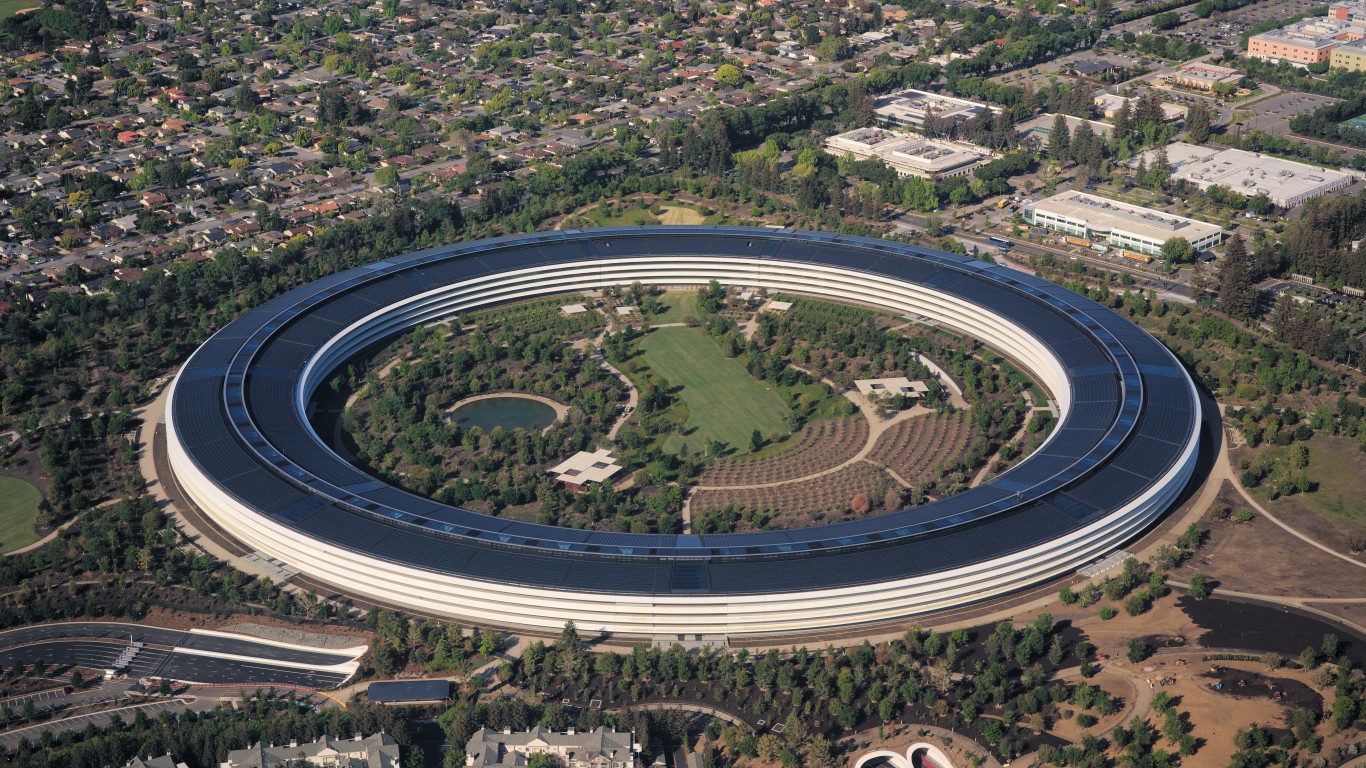
Only three U.S. public companies have market valuations of over $1 trillion. Apple Inc. (NASDAQ: AAPL) is among them, with a value of $1.3 trillion. To stay in the group, Apple will need to do more than just sell iPhones.
The others in the trillion-dollar club are Microsoft Corp. (NASDAQ: MSFT) at $1.4 trillion and Amazon.com Inc. (NASDAQ: AMZN) at $1.2 billion.
The iPhone maker has found out that iPhone sales are its sole key to success. With an installed base of over a billion smartphones, Apple has a chance to sell everything from apps to streaming media to its customers. Services revenue is the future of the company. While Apple TV+ is the most visible part of that business, its many parts already make it a massive and growing segment.
Apple’s New Revenue Story
The headline of Apple’s most recent earnings statement told the story: “Total Revenue Grows, Services Revenue Reaches New All-Time High of $13.3 Billion.”
Apple’s revenue rose only slightly in the period that ended March 28. This year the number was $58.3 billion, compared to $58.0 billion in the same period in 2019. Services revenue rose from $11.5 billion last year.
The second part of the revenue story was that iPhones and Macs are no longer the only hardware with which Apple has had success. Tim Cook, Apple’s chief executive officer, commented in the earnings report: “Despite COVID-19’s unprecedented global impact, we’re proud to report that Apple grew for the quarter, driven by an all-time record in Services and a quarterly record for Wearables.” Apple Watch is at the center of this wearables product line.
The coronavirus pandemic will hurt Apple for several quarters. It already has hit the company, which has shuttered retail stores in many parts of the world.
Apple does not break out Apple Watch results separately. It is part of what the company calls it Wearables, Home and Accessories business. Revenue of this operation at $6.2 billion last quarter topped that of Macs at $5.4 billion. It also bested iPad revenue of $4.4 billion.
What Are Its Services?
The successful services business has several sections. Its main revenue drivers are the App Store, Apple Pay, a consumer cloud services offering and its search ad business. On top of these, Apple Music has over 50 million users.
The most recent addition to this list may be the one Wall Street is most excited about. It is also one that will have the most competition. Apple TV+ recently was launched with a monthly subscription fee of $4.99, which puts it below its primary competition: Amazon Prime, Netflix Inc. (NASDAQ: NFLX) and Walt Disney Co.’s (NYSE: DIS) Disney+.
Netflix has over 150 million worldwide subscribers, and Amazon Prime has over 100 million. Disney recently rose to about 50 million, two years ahead of the schedule it set.
Apple+ does not have its own major studio operations, for now. Richard Plepler, who was CEO of HBO, signed a multiyear deal to produce original content. He is the tip of an iceberg. As the service launched, Zack Van Amburg, Apple’s head of Worldwide Video, said, “With Apple TV+, we are presenting all-original stories from the best, brightest and most creative minds, and we know viewers will find their new favorite show or movie on our service.”
Apple’s Stock Price Continues to Impress
Apple’s shares trade as if there were no recession. The number of analysts who suggest investors should be buying the stock continues to rise.
So far this year, Apple stock is up 5.6%. The S&P 500 is off 11% and the Dow Jones industrial average is down nearly 15% for the same period. Apple is one of the 30 Dow components.
Over the past 12 months, the share price is even more impressive, up 55%. Apple has clobbered the broader market.
Is a Cheaper iPhone a Better iPhone?
With the past several generations of the iPhone, investors worried that improvements were not radical enough to justify price increases.
The early generations of the iPhone were extraordinary inventions. They were smartphones with fast processors. They were light. They had beautiful screens. And they had good enough cameras so that most people could use them for all their photography.
However, the improvements in the processors were less noticeable. Cameras went from very good to so good that only the best photographers could tell the difference. Apple made some versions of the iPhone larger. Yet, the question remained: could the price be justified by the features?
The new iPhone SE is a smaller, simpler iPhone. However, it still has most of the processor and camera features. Its price has been dropped to $399 for the base model.
The current flagship iPhone 11 has a base price of $699. The iPhone 11 Pro has a base price of $999. The iPhone 11 Pro Max has a base price of $1,099.99. With 512 GB of internal memory, that price rises to $1,449.99.
Apple has made a risky decision. The new iPhone SE is a perfect launch at the start of a recession. However, does it cannibalize the sales of more expensive and most likely profitable models? It will take several quarters to surmise if this is a problem. Because Apple does not break out sales or profits by model, the eventual answers will be educated guesses.
Cash, Cash, Cash
Apple has a huge advantage over almost any public company in the world, one that will serve it well in a downturn. At the end of the most recent quarter, current assets included $40 million in cash and cash equivalents and $53.9 billion in marketable securities. Among noncurrent assets, it has $98.8 billion in marketable securities.
Cash generated from operations last quarter totaled $33.5 billion. Apple is rapidly adding to one of the largest company cash piles in the world.
Apple has every chance to remain among the most valuable companies in the world. If the recession is relatively short, even if very deep, Apple’s stock may well rocket higher at the rate it has over the past year.
Thank you for reading! Have some feedback for us?
Contact the 24/7 Wall St. editorial team.
 24/7 Wall St.
24/7 Wall St.


